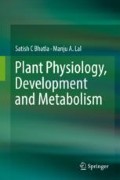Abstract
Besides other roles carbohydrates are the major source of energy for all living beings. Almost 30% of the carbohydrates in plants are utilized for cell wall biosynthesis by each cell. Carbon skeleton also needs to be diverted for synthesis of defense chemicals (secondary metabolites) in order to deter herbivory. This requires a continuous flow of carbohydrates from source to sink. In autotrophic plants CO2 is fixed in green parts resulting in production of simple sugars (monosaccharides). During night, surplus photosynthates stored as transitory starch in chloroplasts are transported to other parts of the plant after being converted to soluble form (Fig. 9.1). Sugars are transported in the least reactive soluble form, primarily as sucrose from source (site of its synthesis) to sink (site of its utilization) though carbohydrates other than sucrose are also translocated, which include raffinose, verbascose, and stachyose. Starch is the primary storage form of carbohydrates. However, there are instances of sucrose being stored also, e.g., in sugarcane and beetroot. In some plants fructans are the storage form of carbohydrates. In members of grass family, starch is stored in the grains. Though carbohydrate metabolism is similar in other organisms, there are certain unique features which make plants distinct. These include their autotrophic nature and the presence of specialized class of organelles, i.e., plastids. Besides plastids, cytosol and vacuoles are also involved in the metabolism of carbohydrates (Fig. 9.2). Because of their inability to move to a safer place under unfavorable environmental conditions, plants have a flexible metabolism and many a times exhibit alternate metabolic pathways. In this chapter, the main focus will be the metabolism of storage form of carbohydrates in plants.
Access this chapter
Tax calculation will be finalised at checkout
Purchases are for personal use only
Suggested Further Readings
Browsher C, Steer M, Tobin A (eds) (2008) Plant biochemistry. Garland Science, Tailor & Francis Group, New York, pp 195–235
Heldt HW (2005) Plant biochemistry, 3rd edn. Elsevier Academic Press, Amsterdam/Boston/Heidelberg, pp 243–269
Jones R, Ougham H, Thomas H, Waaland S (2013) The molecular life of plants. Wiley-Blackwell, Chichester, pp 211–213
Zeeman SC (2015) Carbohydrate metabolism. In: Buchanan BB, Gruissem W, Jones RL (eds) Biochemistry and molecular biology of plants. Wiley-Blackwell, Chichester, pp 567–609
Author information
Authors and Affiliations
Multiple-Choice Questions
Multiple-Choice Questions
-
1.
Inner envelope of chloroplasts have got the:
-
(a)
Antiporters for glucose 6-phosphate/Pi transport
-
(b)
Symporters for triose phosphates and H+
-
(c)
Antiporters for triose phosphates/Pi
-
(d)
Symporters for xylulose 5-phosphate/Pi
-
(a)
-
2.
Temporary starch stored in chloroplasts is known as:
-
(a)
Soluble plastid starch
-
(b)
Transitory starch
-
(c)
Insoluble plastid starch
-
(d)
Phytoglycogen
-
(a)
-
3.
Precursor for sucrose biosynthesis in cytosol is:
-
(a)
ADP-glucose
-
(b)
Glucose 6-phosphate
-
(c)
Fructose 6-phosphate
-
(d)
UDP-glucose
-
(a)
-
4.
Enzyme which catalyzes synthesis of precursor for sucrose biosynthesis is:
-
(a)
UDP-glucose pyrophosphorylase
-
(b)
PPi-dependent phosphofructokinase
-
(c)
Pyrophosphatase
-
(d)
Sucrose-phosphate synthase
-
(a)
-
5.
Sucrose-phosphate synthase is:
-
(a)
Allosterically inhibited by glucose 6-phosphate
-
(b)
Allosterically activated by Pi
-
(c)
Inhibited by phosphorylation of Ser158 residue of the enzyme protein
-
(d)
Activated by phosphorylation of Ser158 residue of the enzyme protein
-
(a)
-
6.
Activity of ADP-glucose pyrophosphorylase is promoted by:
-
(a)
High PGA/Pi ratio
-
(b)
Low PGA/Pi ratio
-
(c)
ATP
-
(d)
When the subunits of the enzymes are oxidized
-
(a)
-
7.
GBSS is responsible for synthesis of:
-
(a)
Semicrystalline starch
-
(b)
Phytoglycogen
-
(c)
Amylopectin
-
(d)
Amylose
-
(a)
-
8.
Phosphorolytic enzymes are so called because they use:
-
(a)
H2O to break glycosidic bonds
-
(b)
ATP to break glycosidic bonds
-
(c)
Pi to break glycosidic bonds
-
(d)
Phosphorylate starch before cleavage
-
(a)
-
9.
β-Amylases are so called because:
-
(a)
They act in addition to another enzyme α-amylase.
-
(b)
They produce β-maltose on hydrolysis of starch.
-
(c)
They are endoamylases.
-
(d)
Maltose is produced on hydrolysis of starch.
-
(a)
-
10.
Phosphorylation of some glucosyl residues of starch by GWD/PWD at the starch grains is required because:
-
(a)
It increases accessibility by hydrolytic enzymes.
-
(b)
It increases hydrophobic nature of the glucosyl residues.
-
(c)
Glucose will be released as glucose 1-phosphate.
-
(d)
Phosphorylated starch is the substrate for the hydrolytic enzymes.
-
(a)
Answers
1. c | 2. b | 3. d | 4. a | 5. c | 6. a | 7. d |
8. c | 9. b | 10. a |
Rights and permissions
Copyright information
© 2018 Springer Nature Singapore Pte Ltd.
About this chapter
Cite this chapter
A. Lal, M. (2018). Metabolism of Storage Carbohydrates. In: Plant Physiology, Development and Metabolism. Springer, Singapore. https://doi.org/10.1007/978-981-13-2023-1_9
Download citation
DOI: https://doi.org/10.1007/978-981-13-2023-1_9
Published:
Publisher Name: Springer, Singapore
Print ISBN: 978-981-13-2022-4
Online ISBN: 978-981-13-2023-1
eBook Packages: Biomedical and Life SciencesBiomedical and Life Sciences (R0)

